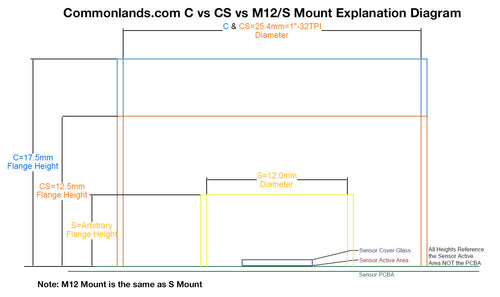Optical lenses for cameras: explore the engineering behind the image capture.
Learn more about camera optical engineering from our US-based engineering team
Camera optical lenses, such as our M12 lenses, are also known as objective lenses. These are multi-element optics constructed from plano-convex, bi-convex, plano-concave, bi-concave, meniscus, aspheric, achromatic doublets, and more. The characteristics of an optical lens contribute to the image quality output from a camera.
In our series of blog posts, we explore the engineering side of imaging optics. We describe the impact on perceptual metrics and considerations needed when building an embedded vision camera system. We also investigate how image quality impacts computer vision, as related metrics will impact lens selection.
How to Focus M12 Lenses - Camera Module Assembly
If you've recently purchased one our M12 lenses or C-Mount lenses, the first step is to assemble your camera. We also offer camera module assembly services in quantities of >100.
Whether you're working on cameras for autonomous robotics, surveillance systems, or other projects, image resolution and sharpness can greatly impact the performance and accuracy of your embedded vision system. That's why understanding how to focus a camera lens is a must-have skill for every robotics engineer or camera hobbyist. In this guide, we provide the techniques, tools, and best practices to help you perfectly focus your camera lens.


What is an M12 lens
How to Clean a Camera Lens
Ever wondered about the best practices to clean a lens or image sensor? In this article we review the impact of a dirty lens and sensor.
We then discuss best practices and tools to clean optics.


CMOS Sensor Size
The sensor format size and pixel size of digital camera impacts many performance attributes of camera.
The format type of a digital camera sensor is one of the most confusing and ridiculous concepts in the vision industry.
Lens Chief Ray Angle and Mismatch
The magnitude of impact from CRA mismatch can be.


Resolution 101

Wide Angle Lenses and Fisheye Camera Lens Distortion
Optical distortion is a third order transverse aberration. The simple explanation is that distortion is the change in magnification (angular resolution) versus image height.
GoPro's marketing team was stuck with "Fisheye" because the first product used a cropped Fisheye lens. The newer GoPros use Wide Angle lenses which are not Fisheye lenses.
An Overview Of CCTV/CMOS Lens Mount Types
Max Henkart
Fri Jul 24 2020
One of the first questions inevitably asked when designing vision systems is a variant of the following:
- Will my CS Mount Lens work with my C Camera Mount?
- Will my C Mount Lens work with my CS Camera Mount?
- What is the difference between a S Mount lens and a M12 lens?


Raspberry Pi Video Conferencing
Image Quality Summit
This post explores 12+ Image Quality Metrics and the impact on computer vision. The blog posts and video are from a talk that Max H gave during the Embedded Vision Summit 2022.
- Camera Exposure and Computer Vision
- Motion Blur
- High Dynamic Range
- Resolution and Sharpness
- Shading and Vignetting
- Noise
- Fisheye Distortion and Wide Angle Lenses
- Fringing and Chromatic Aberration

